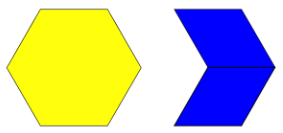22.1: How Many Groups? (Part 1)
( \newcommand{\kernel}{\mathrm{null}\,}\)
Lesson
Let's play with blocks and diagrams to think about division with fractions.
Exercise 22.1.1: Equal-Sized Groups
Write a multiplication equation and a division equation for each sentence or diagram.
- Eight $5 bills are worth $40.
- There are 9 thirds in 3 ones.

Exercise 22.1.2: Reasoning with Pattern Blocks
Use the pattern blocks in the applet to answer the questions. (If you need help aligning the pieces, you can turn on the grid.)
- If a hexagon represents 1 whole, what fraction do each of the following shapes represent? Be prepared to show or explain your reasoning.
- 1 triangle
- 1 rhombus
- 1 trapezoid
- 4 triangles
- 3 rhombuses
- 2 hexagons
- 1 hexagon and 1 trapezoid
- Here are Elena’s diagrams for 2⋅12=1 and 6⋅13=2. Do you think these diagrams represent the equations? Explain or show your reasoning.

- Use pattern blocks to represent each multiplication equation. Remember that a hexagon represents 1 whole.
- 3⋅16=12
- 2⋅32=3
- Answer the questions. If you get stuck, consider using pattern blocks.
- How many 12s are in 4?
- How many 23s are in 2?
- How many 16s are in 112?
Summary
Some problems that involve equal-sized groups also involve fractions. Here is an example: “How many 16 are in 2?” We can express this question with multiplication and division equations.
?⋅16=2
2÷16=?
Pattern-block diagrams can help us make sense of such problems. Here is a set of pattern blocks.

If the hexagon represents 1 whole, then a triangle must represent 16, because 6 triangles make 1 hexagon. We can use the triangle to represent the 16 in the problem.

Twelve triangles make 2 hexagons, which means there are 12 groups of 16 in 2.
If we write the 12 in the place of the “?” in the original equations, we have:
12⋅16=2
2÷16=12
Practice
Exercise 22.1.3
Consider the problem: A shopper buys cat food in bags of 3 lbs. Her cat eats 34 lb each week. How many weeks does one bag last?
- Draw a diagram to represent the situation and label your diagram so it can be followed by others. Answer the question.
- Write a multiplication or division equation to represent the situation.
- Multiply your answer in the first question (the number of weeks) by 34. Did you get 3 as a result? If not, revise your previous work.
Exercise 22.1.4
Use the diagram to answer the question: How many 13s are in 123? The hexagon represents 1 whole. Explain or show your reasoning.

Exercise 22.1.6
Write two division equations for each multiplication equation.
- 15⋅25=6
- 6⋅43=8
- 16⋅78=14
Exercise 22.1.7
Noah and his friends are going to an amusement park. The total cost of admission for 8 students is $100, and all students share the cost equally. Noah brought $13 for his ticket. Did he bring enough money to get into the park? Explain your reasoning.
(From Unit 4.1.2)
Exercise 22.1.8
Write a division expression with a quotient that is:
- greater than 8÷0.001
- less than 8÷0.001
- between 8÷0.001 and 8÷110
(From Unit 4.1.1)
Exercise 22.1.9
Find each unknown number.
- 12 is 150% of what number?
- 5 is 50% of what number?
- 10% of what number is 300?
- 5% of what number is 72?
- 20 is 80% of what number?
(From Unit 3.4.5)

